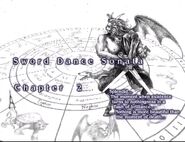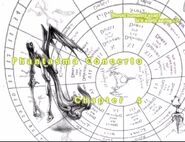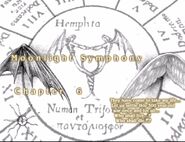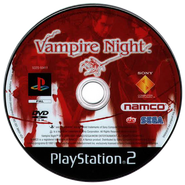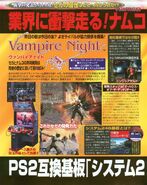(Condensed some information.) Tag: Visual edit |
Tag: Visual edit |
||
| Line 76: | Line 76: | ||
=== Gameplay === |
=== Gameplay === |
||
| − | Tomoyasu altered ''[[The House of the Dead (1996 video game)|The House of the Dead]] ''and ''[[The House of the Dead 2|''The House of the Dead 2'']]''<nowiki/>'s civilian mechanic so that players must "[snipe]" small parasites from their bodies; |
+ | Tomoyasu altered ''[[The House of the Dead (1996 video game)|The House of the Dead]] ''and ''[[The House of the Dead 2|''The House of the Dead 2'']]''<nowiki/>'s civilian mechanic so that players must "[snipe]" small parasites from their bodies; shooting the civilian instead transforms them into a vampire enemy. To balance ''Vampire Night''<nowiki/>'s difficulty, Tomoyasu removed life penalties from shooting civilians and increased the player's bullet count from 6 to 8.<ref name=":0">[https://translate.google.com/translate?hl=&sl=auto&tl=en&u=https%3A%2F%2Fgame.watch.impress.co.jp%2Fdocs%2F20011228%2Fvpk.htm&sandbox=1 Game Watch - "Vampire Night" Developer Interview]</ref> |
The "attack gauge" mechanic initially did not exist in development, but Tomoyasu created it because he thought ''The House of the Dead 2''<nowiki/>'s bosses were quite difficult. He envisioned that the attack gauge would help players see how close they were to successfully stopping a boss phase.<ref name=":0">[https://translate.google.com/translate?hl=&sl=auto&tl=en&u=https%3A%2F%2Fgame.watch.impress.co.jp%2Fdocs%2F20011228%2Fvpk.htm&sandbox=1 Game Watch - "Vampire Night" Developer Interview]</ref> Since the release of ''Vampire Night'', Tomoyasu's concept has been used in further ''House of the Dead ''games, beginning with ''[[The House of the Dead III]] ''in 2002. |
The "attack gauge" mechanic initially did not exist in development, but Tomoyasu created it because he thought ''The House of the Dead 2''<nowiki/>'s bosses were quite difficult. He envisioned that the attack gauge would help players see how close they were to successfully stopping a boss phase.<ref name=":0">[https://translate.google.com/translate?hl=&sl=auto&tl=en&u=https%3A%2F%2Fgame.watch.impress.co.jp%2Fdocs%2F20011228%2Fvpk.htm&sandbox=1 Game Watch - "Vampire Night" Developer Interview]</ref> Since the release of ''Vampire Night'', Tomoyasu's concept has been used in further ''House of the Dead ''games, beginning with ''[[The House of the Dead III]] ''in 2002. |
||
Revision as of 22:32, 21 May 2020
(Vampire Night, Sega Golden Gun, and others)
Let us settle this once and for all. Who shall live and who shall die.
Flyer
Vampire Night (ヴァンパイアナイト, Vanpaia Naito) is a horror-themed rail shooting game developed by Sega WOW Entertainment (formerly Sega AM1) and published by Namco in 2000. Originally released to arcades, it was ported to the PlayStation 2 in December 2001.
Set in an alternate universe, centuries after a conflict between humans and vampires, the game follows vampire hunters Michel and Albert as they battle the forces of Count Auguste.
Jointly developed by Sega, WOW Entertainment, and Namco, Vampire Night draws heavy influence from the gameplay and presentation of the House of the Dead series.
Plot
Setting
Vampire Night takes place in an alternate version of France in 2006, when progress became stuck in the late 19th century. The first two chapters take place in French villages, while the remaining four take place in the castle of Count Auguste.
Each level has an elemental/primal motif: air, earth, fire, darkness, water, and light.
Characters
The main antagonist is Count Auguste, the leader of the vampires, who tires of immortality and creates vampire hunters Michel and Albert -- the protagonists -- to end his life. Auguste soon fears death, stripping the hunters of their powers and sending his loyal followers to kill them.
The members of Auguste's court include Bathe'lemy, a knight who is curious about death; Guillaume, a former scientist who conducted cruel human experiments; Raoul, a fencer who seeks avenging his love interest by killing humans; and Diane, a mermaid who became a vampire after falling in love with Auguste.
Accompanying Michel and Albert on their journey is Caroline, a young girl whose village was ravaged by vampires.
Synopsis
300 years ago in a battle against the Vampire Hunters, Auguste desired to end his life. When he began to fear death, however, the Vampire Hunters lost their strength since Michel and Albert were merely shadows created by Auguste to kill himself. Now, 300 years later, Auguste wished to end the battle once and for all...
The Past II
300 years after a battle between humans and vampires, Count Auguste tires of immortality and wishes to end his own life. He creates vampire hunters Michel and Albert to achieve this, but grows fearful of death and enlists his followers to stop them.
In 2006, Michel and Albert travel through France to Auguste's castle. They rescue a young girl, Caroline, from villagers under the influence of the vampiric parasite Sarcoma. A knight serving under Auguste named Bathe'lemy duels the hunters in the city square, but is defeated.
In the castle, Caroline is kidnapped by the mad scientist Guillaume, who battles the hunters on a rooftop; upon defeat, he refuses to be killed by humans and commits suicide. Later, fencer Raoul challenges the hunters, seeking revenge on humanity after the death of his lover Sophie. Raoul sacrifices his soul to become a vampire, but upon defeat becomes human again; Michel urges him to "live life as a human" and to "fight [his] soul once again".
Auguste's lover, the mermaid Diane, insists that she stop the hunters. Caroline begs that a compromise be reached between humans and vampires, which Diane rejects. Diane transforms into a vampire, but is ultimately defeated; before dying, she considers Caroline's idea as a possibility.
Michel and Albert confront Auguste, who transforms into his vampire form to do battle. Although Auguste is killed, the hunters -- their mission completed -- let the rising sun end their own lives as well.
Six months later, Caroline pays her respects the vampire hunters' graves, stating that "[her] heart shall remember all.... That day, that moment, and what happened". The game ends as her summer hat gets carried away by the wind.
Gameplay
Vampire Night recycles numerous gameplay mechanics from the House of the Dead games. Players shoot approaching enemies with a light gun and reload by shooting outside the screen. The guns can shoot up to 8 bullets before reloading. Damage from enemies removes a life; losing them all results in a game over. Bonus lives are awarded by rescuing villagers, finding life-up icons in destructable objects, or earning a good ranking at the end of a level. Chapters 2, 3, and 4 also have branching paths, where the player's actions alter the route through the levels.
Villagers behave similarly to the civilians from the House of the Dead series in that they often award bonus lives, but are under the influence of the Sarcoma parasite. The player must shoot the Sarcoma in order to rescue them; failure results in the villager becoming a vampire enemy but there is no life penalty.
Enemy health is measured by health bars that appear over their bodies. Every enemy has a weak point that must be shot to kill them quicker. Bosses have health bars as well as a "cancel" meter, which must be depleted quickly in order to stop attacks.
Chapters
Development
Inception and concept
Yoshinori Tomoyasu, the planner of Sega WOW Entertainment, sought developing a game on Namco's PlayStation 2-based System 246 arcade hardware.[1] He was then introduced to Namco president Masaya Nakamura by former Sega AM1 head Rikiya Nakagawa.[1] Ultimately, both companies collaborated: Sega would produce a game on the System 246 hardware, with Namco helping manufacture and distribute it.[2] In addition, Sega adopted Namco's practice of porting System 246 arcade titles to the PlayStation 2.[3]
Tomoyasu served as the director and planner of Vampire Night.[1] Takashi Oda, the director of the main House of the Dead series, was also involved in development.[4] The game was inspired by the 1999 science fiction film The Matrix.[1] Although the vampire hunters were given more character than protagonists in the House of the Dead games, more focus was placed on boss design.[1]
Gameplay
Tomoyasu altered The House of the Dead and The House of the Dead 2's civilian mechanic so that players must "[snipe]" small parasites from their bodies; shooting the civilian instead transforms them into a vampire enemy. To balance Vampire Night's difficulty, Tomoyasu removed life penalties from shooting civilians and increased the player's bullet count from 6 to 8.[1]
The "attack gauge" mechanic initially did not exist in development, but Tomoyasu created it because he thought The House of the Dead 2's bosses were quite difficult. He envisioned that the attack gauge would help players see how close they were to successfully stopping a boss phase.[1] Since the release of Vampire Night, Tomoyasu's concept has been used in further House of the Dead games, beginning with The House of the Dead III in 2002.
Gallery
Arcade flyers
Game covers
Game discs
Magazine articles
Promotional advertising
References
- ↑ 1.0 1.1 1.2 1.3 1.4 1.5 1.6 Kawamoto, Masumi (December 28, 2001). 特別インタビュー (Japanese). GAME Watch. Archived from the original on April 22, 2020. Retrieved on May 21, 2020.
Cite error: Invalid
<ref>tag; name ":0" defined multiple times with different content Cite error: Invalid<ref>tag; name ":0" defined multiple times with different content Cite error: Invalid<ref>tag; name ":0" defined multiple times with different content Cite error: Invalid<ref>tag; name ":0" defined multiple times with different content Cite error: Invalid<ref>tag; name ":0" defined multiple times with different content Cite error: Invalid<ref>tag; name ":0" defined multiple times with different content - ↑ IGN Staff (February 15, 2001). One Tiny New Detail on Vampire Night. IGN. Archived from the original on April 22, 2020. “Sega will be developing the Vampire Night game using Namco's PS2-based System 246 arcade hardware. Namco, in addition to supplying the base hardware, will manufacture the game and distribute it to arcades. All this is part of an arcade partnership deal between the two companies that was announced last year.”
- ↑ IGN Staff (February 13, 2001). Namco and Sega Join Hands on Arcades. IGN. Archived from the original on December 5, 2013. “In the future, Sega plans to further adopt Namco's program, in which games that are developed on Namco's proprietary System 246 -- which is compatible with PlayStation 2 -- will then most likely be ported to PS2 sometime in the future. Using this system [requires] less programming in required for porting, and therefore costs less for both developer and publisher... Sega plans to bolster its profitable arcade game operations and increase supply of software for PlayStation 2.”
- ↑ Kori (September 7, 2012). "Website of the Dead’s Exclusive Interview with Takashi Oda". The Website of the Dead. Archived from the original on April 19, 2020. “Other than The House of the Dead, I have worked on mostly arcade shooters like “Vampire Night” and “Rambo”.”
External links
- https://bandainamco-am.co.jp/am/vg/vampirenight
- https://www.bandainamcoent.co.jp/cs/list/vampirenight/
v • e content content
| |||
|---|---|---|---|


